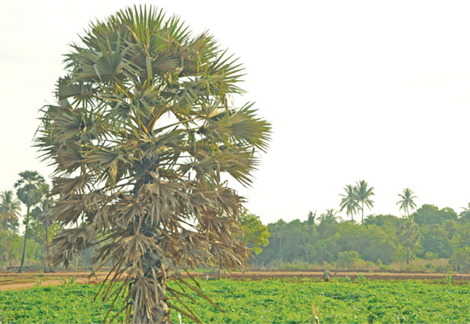|
No economic dividends to people:
Development challenges and prospects
By Gamini Warushamana
In the Eastern Province the civil war ended in July 2007 and in the
North it was in May 2009. During this long period there has been a
significant development in physical infrastructure in the two provinces
but the dividends of post-war development has not passed on to the
people, principal researcher of the Point Pedro Institute of Development
(PPID), Muttukrishna Sarvananthan told Sunday Observer Business.
 Excerpts of the interview Excerpts of the interview
If we look at national level economic data they are good despite
reservations that many of us have on its accuracy. A sound GDP growth
rate of around 7.5 percent for the four-year period from 2010-2013,
rising per-capita GDP, single digit inflation continuously for over five
years, official unemployment rate as low as 4.4 percent in 2013 and
poverty head count ratio declining to 6.7 percent in 2013, paints a rosy
picture of the economy.
Mismatch
However, if we look at provincial data, especially the Northern and
the Eastern provinces, the picture is not rosy and it is clear that the
peace dividend has not passed on to the people. There is a serious
mismatch between the national figures and provincial data and,
therefore, they do not give a true picture.
For instance in 2011 and 2012, the North has the highest provincial
GDP growth and the East the second highest. In 2008 and 2009, the
Eastern province had the highest GDP growth. As we know per-capita GDP
is measured by total GDP divided by the population of the country.
But GDP comes from different sources including big private companies,
government agencies and big financial institutions. Therefore, the best
way of ascertaining the changes in household income is by looking at the
changes in the Household Income and Expenditure Survey (HIES) data.
According to HIES data, the per capita GDP is less than one-fourth of
the real national per capita GDP. Moreover, unemployment is the highest
in the North and the East and is over 20 percent compared to the
national figure of 4.4 percent.
Preferential treatment
Poverty too is higher in the two provinces and the poverty head count
ratio according to 2012-2013 statistics are - Mullaithivu 28.8 percent,
Mannar 20.1, Kilinochchi 12.7, Jaffna 8.3, Vauniya 3.4 and Batticaloa
19.4.
After 2005, President Mahinda Rajapaksa's regime spent a huge amount
of money on three provinces, the North, the East and the South for
physical infrastructure development. It is a well-known fact that the
South gets preferential treatment as it is the former President's
hometown.
In the Northern and the Eastern provinces, physical infrastructure
development is the main component of post-war reconstruction work.
After the end of the war, construction sub sector growth increased
significantly. It is natural in any post-conflict country.
For instance in monetary terms, the construction sub sector has grown
by 56 percent from 2010-2012. In addition some of the delayed tsunami
reconstruction projects were also launched after the end of the war.
Whatever the reason, the fund allocation for physical infrastructure
development for the Northern and the Eastern provinces was the highest
recorded since Independence.
Jobless development
We have to look at what went wrong and why the invested money has not
trickled down to the masses and why it has become jobless development.
My view is the government wanted fast tracked development and to
complete the projects immediately and, therefore, all the projects were
capital intensive.
Moreover, Chinese and Indian contractors brought labourers from their
countries and, therefore, there were no job opportunities for local
people. Lack of skilled and semi-skilled construction workers in the
North and the East was also a reason. Therefore, capital investments did
not create job opportunities for local people and did not increase their
income because they were kept out.
Political motives
The government had political motives to fast track the projects. It
wanted to demonstrate post-war reconstruction and development to the
world because global attention was focused on alleged human rights
violations and war crimes on one hand and on the other hand there was a
rush to go for Provincial Council and national elections.
 The motivation for rapid implementation of the projects were for
political dividends to the ruling coalition rather than economic
dividends to the people. This disparity can be clearly seen in
statistics. The motivation for rapid implementation of the projects were for
political dividends to the ruling coalition rather than economic
dividends to the people. This disparity can be clearly seen in
statistics.
Although the construction sub sector grew by 56 percent from
2010-2012 in the two provinces, the employment growth during the period
was only 5.4 percent. This is totally different compared with the South.
In the Southern Province, the construction sub sector grew at 37
percent and employment growth was 27 percent.
It is clear that the booming construction sector did not give jobs or
income to the people in the North and the East.
This is against the development strategy adopted by the International
Labour Organisation (ILO) for conflict-affected countries.
The ILO proposes labour intensive infrastructure projects and
countries such as Cambodia successfully followed this strategy.
Even in Sri Lanka this strategy was practiced in infrastructure
development projects during the ceasefire in 2001.
Livelihood support
"I do not say all the investments on physical infrastructure
development were a flop. Improved road connectivity has created a market
for fish and agricultural products. Transportation on the A-9 road is
good but despite good roads, public transportation in the interior areas
of the province is still poor."
The government did not have livelihood support programs for the
war-affected families after they were resettled. In most
conflict-affected countries financial support was given to the affected
people in the post-conflict situation.
There was no compensation for damaged properties at all.
Reconstruction of houses was not taking place in most parts of the two
provinces. There is progress in the Jaffna district mainly because of
the remittances by a large number of expatriates.
The Army has constructed some houses and the Indian housing scheme
too is dragging on at a slow pace and only 27,000 houses have been
completed so far.
|

Muttukrishna Sarvananthan |
Since the war dragged on for 30 years we cannot expect everything to
be put right quickly. Some issues such as poverty cannot be addressed
without specially targeted poverty alleviation programs. The Samurdhi
program is a political program that does not focus on poor people.
High cost
The common features in recent mega infrastructure development
projects are exorbitantly high costs and lack of prioritisation. For
instance, the Mulaitivu district has the lowest population in the
country and its cattle population is higher than the human population.
Therefore, the construction of six-lane or four-lane highways is not the
first priority here.
Although a huge amount of money has been invested in road development
there has been no dairy sector development in the district. This
mismatch of development programs has been common in the recent past.
Strict restrictions on NGOs too has affected development in the North
and the East. The Government was suspicious of local and foreign NGOs
and its activities were restricted especially in the North and the East.
INGOs and NGOs play an important role in countries where the
Government administrative service is weak in delivering essential
services to the people.
In Sri Lanka, INGOs had provided over $ 100 million annually and
these are entirely grants. Government policies stopped these
investments.
Future
To boost economic growth in the North and the East, there should be
an integration of these provinces with the rest of the country and the
rest of the world.
Integrated transport sector development should be the first priority
by developing and linking KKS harbour, Palali airport and the Northern
railway line.
Short-sighted politically motivated infrastructure development plans
will not bring prosperity to these provinces.
Construction of the second line in the Northern railway should be the
priority than the construction of the proposed expressway.
Railway is the efficient and cost effective mode in goods and
passenger transportation. Development of the KKS harbour is vital to
launch export processing zones and attract investment for manufacturing
industries in the North.
The airstrip of the Palaly airport should be developed to accommodate
bigger aircraft and start direct flights to some destinations in India
at least.
In the 1970s, there were direct Air Ceylon flights between Palaly and
Trichi.
This will help boost the Northern province economy in many ways.
The large expatriate population of the North province, tourism sector
growth especially from India and tourism packages with India and
development of IT BPM industry will benefit.
The proposed land connectivity between Thalaimannar and Rameshwaram
in India too should be a priority. India, one of the fastest growing
economies in the world is at our doorstep but still we have not
exploited this huge market.
If we take Tamil Nadu with a population of over 70 million, higher
than the population of England, it is a huge market.
Tamil Nadu is the hub of the Indian automobile industry where many
global brands have set up assembly lines.
"We should have a plan to enter these supply chains by producing
small parts. Land connectivity with India would definitely boost trade,
investment and tourism between the two countries. The connectivity
improvements will make Sri Lanka a financial hub to the fast growing
Indian economy.
However, there should be a pragmatic political leadership with
strategic thinking to exploit these opportunities.
Suspicion based on the unpleasant past should not hinder economic
development.
The Point Pedro Institute of Development (PPID) was set up in 2004,
to revive the knowledge and intellectual bases of the Northern and the
Eastern Provinces.
The PPID which has a comprehensive knowledge base of the Sri Lankan
and global economy has focused research on development issues in the
North and the Eastern Provinces. Muttukrishna Sarvananthan who hails
from Point Pedro and a Development Economist, is the founder and
principal researcher of the PPID. |

